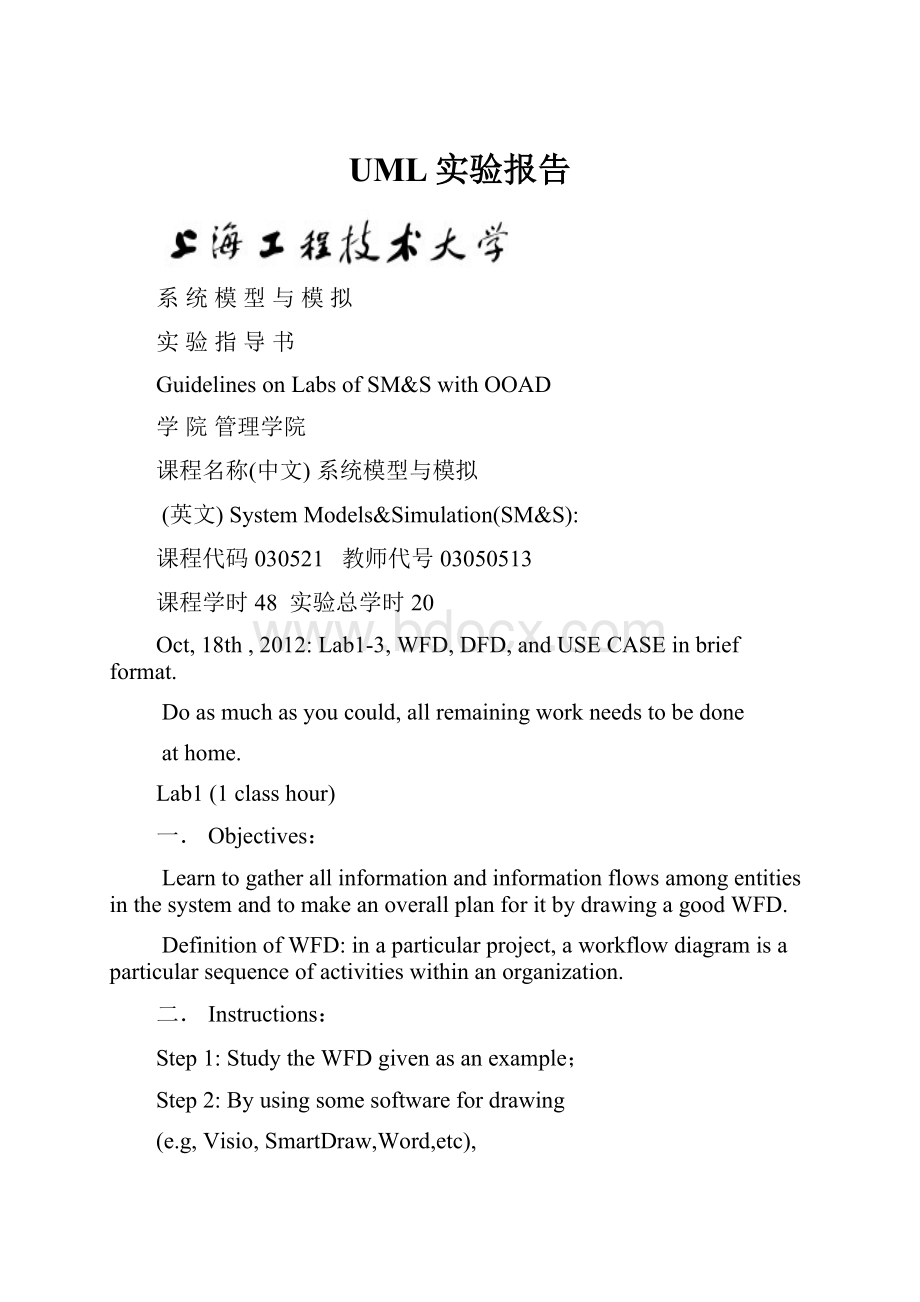UML实验报告.docx
《UML实验报告.docx》由会员分享,可在线阅读,更多相关《UML实验报告.docx(27页珍藏版)》请在冰豆网上搜索。

UML实验报告
系统模型与模拟
实验指导书
GuidelinesonLabsofSM&SwithOOAD
学院管理学院
课程名称(中文)系统模型与模拟
(英文)SystemModels&Simulation(SM&S):
课程代码030521教师代号03050513
课程学时48实验总学时20
Oct,18th,2012:
Lab1-3,WFD,DFD,andUSECASEinbriefformat.
Doasmuchasyoucould,allremainingworkneedstobedone
athome.
Lab1(1classhour)
一.Objectives:
LearntogatherallinformationandinformationflowsamongentitiesinthesystemandtomakeanoverallplanforitbydrawingagoodWFD.
DefinitionofWFD:
inaparticularproject,aworkflowdiagramisaparticularsequenceofactivitieswithinanorganization.
二.Instructions:
Step1:
StudytheWFDgivenasanexample;
Step2:
Byusingsomesoftwarefordrawing
(e.g,Visio,SmartDraw,Word,etc),
DrawaWFDforthesystemyouhavebasedonyourunderstanding
ofthegivenexampleaswellasthesystem;
Step3:
SubmittheWFDafteryoupolishit;
Lab2(0.5classhour):
一.Objectives:
AnalyzealldataanddataflowsamongprocessesinthesystemanddesignaDFDtobetterunderstandtheprocessingsystem.
DefinitionofDFD:
describeprocessesofinformationstoring,inputandoutputthattransformdataintoandfromthesystembetweensourcesanddestinations.
二、Instructions:
Step1:
StudytheDFDgivenasanexample;
Step2:
Byusingsomesoftwarefordrawing(e.g,SmartDraw,Word,etc),
DrawaDFDforthesystemyouhavebasedonyourunderstanding
ofthegivenexampleaswellastheprocessingsystem;
Step3:
SubmittheDFDafteryoupolishit;
Step4:
Gohomeandhappyafterturnoffcomputers.
Lab3(0.5classhour):
一.Objectives:
Apprehend(understand)theconceptofUseCasesinyourTextbookandidentifyUseCasesinthesystemtoanalyzerequirementsofthesystem.
ReflectthedifferencesbetweenrequirementsofthesystemanddynamicfeaturesfortheJavaclassesandcreateaninitialUseCaseforthesysteminbriefformat.
二.Instructions:
Step1:
Analyzeyoursystemtofindoutsomeinitialrequirements.
Step2:
Figureoutappropriatename(verbphrases)forapossibleUse
Case;
Step3:
FindouttheActor(primaryrolename)oftheUseCase.
Step4:
writethemainscenarios(SuccessScenarios)oftheUse
Caseinbriefformat.
Step5:
Submityourworkwhenfinishit.
Oct,25th,2012:
Lab4-5,
1OneUSECASEinformalformat(twocolumnsinatable).
2DomainModelwithattributes
Doasmuchasyoucould,allremainingworkneedstobedone
athome.
Lab4(1classhours):
二.Objectives:
Apprehend(understand)theconceptofUseCasesinyourTextbookandidentifyUseCasesinthesystemtoanalyzerequirementsofthesystem.
ReflectthedifferencesbetweenrequirementsofthesystemanddynamicfeaturesfortheJavaclassesandcreateaformalUseCaseforthesystem.
二.Instructions:
Step1:
Analyzeyoursystemandpreviousartifactstofindoutsomerequirements.
Step2:
Figureoutappropriatename(verbphrases)forapossibleUse
Case;
Step3:
FindouttheActor(rolename)oftheUseCase.
Step4:
writethemainscenarios(SuccessScenarios)oftheUse
Caseintheformatofcolumns(atable).
UsecaseinFormalFormat
UseCaseName
SalesProcessingSystemforBookplace,Inc.
Actor(s)
Client
Description
TheUseCasedescribestheprocessofthesalesorder,whencompleted,clientwillgetthepinkinvoicecopyandbook(s).
TypicalCourseOfEvents
ActorActon
SystemResponse
Step1:
TheusecaseisinitiatedwhentheaclientsubmitsanIntenttoPurchase.
Step2:
Aletterorpurchaseorderthatgivestheclient’sbillingandshippinginformation.
Step3:
clientidentifiestheitemstobepurchased.
Step4:
Clientbillfordeorder.
Step5:
Accountingsendsthewhiteandthepinkcopiestoclients.
Step6:
TheclientsubmitsthepaymentwiththepinkcopytotheAccounting.
Step7:
ASalesandAcquisitionclerkshipsthepinkcopyandthebook(s)totheclient
Step8:
Whentheclientgetsbook(s),theusecaseends.
Lab5(1classhours):
一.Objectives:
CreateaninitialDomainModelforyoursystemandidentifyanumberofconceptualclassesinthedomain.
KnowthedifferencesbetweenconceptualclassesanddesignclasseswhichareclosetoJavacodebywritingapieceofJavacode.
二.Instructions:
Step1:
Studythesystemasadomaininyourcasematerial;
Step2:
Identifyanumberofconceptualclasseswhichusuallyrefer
torealobjectsintherealworldandarecloselyrelatedto
yourdomain.
Step3:
DrawrectanglestodepicttheconceptualclassesbyusingUML;
Step4:
Trytoidentifyappropriateattributesforeachof
conceptualclassesintheDM.
Step5:
Submityourworkwhenfinishit.
PurchaseOrder
ItemNumber
Title
Time
Quantity
Client
ID
Name
Address
Phone
Interest
PONumber
Payment
total
salestax
Clerk
ID
Name
Sales
Date
BookID
SalesPrice
Invoice
Invoice
Subtotal
Salestax
Shippingandhandlingcharges
Total
Book
Code
Author
Title
Source
CurrentPrice
Accounting
WorkID
Name
Nov,1st,2012:
Lab6-7,
●DesignDomainModelswithattributes、associations
andmultiplicities;
●TrytodesignUSECASEdiagram,nottextforyoursystems,OrwriteanotherUSECASEtextinformalformat,differentfromthelastoneyoucreatedlastweek.
Doasmuchasyoucould,allremainingworkneedstobedone
athome.
Lab6(1classhour):
一.Objectives:
CreateacompleteDomainModelforyoursystemandidentifyanumberofconceptualclasses、attributes、associationsandmultiplicitiesinthedomain.
KnowthedifferencesbetweenconceptualclassesanddesignclasseswhichareclosetoJavacodebywritingapieceofJavacode.
二.Instructions:
Step1:
Studythesystemasadomaininyourcasematerial;
Step2:
Identifyanumberofconceptualclasses;
Step3:
DrawrectanglestodepicttheconceptualclassesbyusingUML;
Step4:
Trytoidentifyappropriateattributes、associationsandmultiplicitiesforeachofconceptualclassesintheDM.
Step5:
Submityourworkwhenfinishit.
DMForBookPlace
Lab7(1classhour):
三.Objectives:
Apprehend(understand)theconceptofUseCasesinyourTextbookandidentifyseveralUseCasesinthesystemtocreateaUSECASEdiagram.
ReflectthedifferencesbetweenaUSECASEdiagramandaUSECASEtext.
二.Instructions:
Step1:
Analyzeyoursystemandpreviousartifactstofindoutsomerequirements.
Step2:
Figureoutappropriatenames(verbphrases)forafewpossibleUseCases;
Step3:
ConnecttheUSECASEstoformadiagramwithproperrelations.
Step4:
FindouttherelationshipbetweenaUseCasediagramandaUSECASEText.
Step4:
Writethemainscenarios(SuccessScenarios)oftheUse
Caseintheformatofcolumns(atable).
Nov,8th,2012:
Lab8,
DesignSSDs(oneisok,twoisbetter,Javacodeisoptional)
Lab8(2classhours)
一Objectives:
AnalyzetheUseCasesandDesignSSD(SystemSequenceDiagram)basedonmainsuccessfulscenariosandcomparetheoperationsintheSSDtothemethodsinJavacode.
ReflectthedifferencesbetweentheoperationsintheSSDandthemethodsinJavacode.
二.Instructions:
Step1:
Analyzeyoursystemtofindoutsomeoperationsofthesystem.
Step2:
Figureoutpropername(verbphrases)forEventoftheSystem.
Step3:
Figureoutappropriatenames(verbphrases)foroperations
ofthesystem.
Step4:
Findouttheappropriatemessagesdisplayedbythesystem.
Step5:
Refertothetextbookonp174-175anddesignamajorSSDfor
thesystem(SuccessfulScenariosoftheUseCase).
Step6:
TrytowriteaJavaprogramwhichcontainsmajorfunctions
describedintheSSD.
Step7:
Submityourworkwhenfinishit.
Nov,15th,2012:
Lab9:
DesigninitialDCD
Lab9(2classhours,2012/11/15):
一Objectives:
AnalyzetheDomainModelsandSSD(SystemSequenceDiagram)basedonmainsuccessfulscenariosandDesignaninitialClassDiagrams(DCD).
ReflectthedifferencesbetweentheconceptualclassesintheDManddesignclassesintheDCD.
二.Instructions:
Step1:
AnalyzeDomainModelsandSSDtofindoutsomedesignclasses
forthesystem.
Step2:
RefertotheDomainModelsanddesigntheDesignClassDiagram
Whichcontainsclassname,staticattributes,anddynamic
Methods.
Step3:
Submityourworkwhenfinishit.
Client
ID:
int
Name:
text
Address:
String
Phone:
String
Interest:
String
+SubmitPurchase()
+Submitpayment()
PurchaseOrder
ItemNumber
Time:
Datetime
Total:
float
Quantity:
int
+Createonder()
+Deleteorder()
+Changeitem()
Clerk
ID:
string
Name:
string
+getInvoice()
+fileInvoice()
Payment
total:
float
salestax:
float
Sales
Date:
TimeDate
BookID:
string
SalesPrice:
float
Book
Code:
int
Author:
string
Title:
string
Source:
string
CurrentPrice:
float
Invoice
Subtotal:
float
Salestax:
float
Shippingandhandlingcharges
Total:
float
+getSubtotal()
Nov,22nd,2012:
Lab10:
DesignacompleteDCD
Lab10(2classhours)
一Objectives:
AnalyzetheDomainModelsandSSD(SystemSequenceDiagram)basedonmainsuccessfulscenariosandDesignacompleteClassDiagrams(DCD).
ReflectthedifferencesbetweentheconceptualclassesintheDManddesignclassesintheDCD.
二.Instructions:
Step1:
Designattributes,operationsandassociationsfortheDCD;
.
Step2:
RefertopreviousartifactsyoudesignedandrefinetheDCD;
Step3:
Submityourworkwhenfinishit.
DCDforSalesProcessingSystemofBookplace,Inc.
Nov,29th–Dec,6th,2012:
Lab11-12:
DesignaSDandMapDCDintoJavacode
Lab11(2classhours)
一Objectives:
AnalyzetheDomainModelsandSSD(SystemSequenceDiagram)basedonmainsuccessfulscenariosanddesignSequenceDiagrams(SD).
Reflectthedifferencesbetweenop